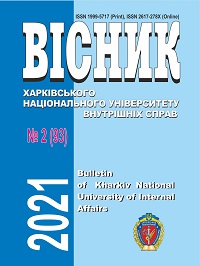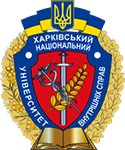Problematic Issues on the Organization of Selecting Person’s Biological Samples for Molecular and Genetic Examination
Abstract
The article is focused on the procedure of sampling as a criminal procedural action necessary for the commissioning and carrying out molecular genetic expert examination in the divisions of the Expert Service of the Ministry of Internal Affairs, namely the establishment and comparison of genetic traits of living and dead persons and unidentified corpses within criminal proceedings and civil cases for establishing or refutation of the fact of paternity. The purpose of the work is to provide information about human biological material that can be used as samples for molecular genetic research of living and dead people and unidentified corpses; analysis of errors during sampling of biological material of individuals for each type of samples and determining the methods of storage and transportation of research objects depending on their condition. The author has studied the legal aspects of the procedure of selecting the samples of biological origin according to the rules of identity examination and has indicated the list of documents required for sampling relatives of missing persons for the placement in the central database of human genetic traits. The author has specified the basic requirements for sampling, such as their indisputable belonging to a certain person and reliability of their selection in the minimum quantity necessary for the research. The information that should be indicated on the packaging of biological material has been described. The types of biological material that can be provided for the research as living specimens have been separately studied, namely: nails, blood, buccal epithelium, saliva, which can be provided on a piece of sterile gauze, FTA Cards, cotton, viscose or flock sticks or probe swabs. The author has also defined the persons who have the right to carry out selection from living persons, conditions of selection, drying of samples, possibilities of their long-term storage and conditions of transportation to divisions of the Expert Service of the Ministry of Internal Affairs of Ukraine. Errors in selecting the packaging of biological material (catheters with heparin filling, Ames medium, polymer containers) have been analyzed. Blood, bone remains, teeth, nails and histological specimens have been studied as types of biological material taken from dead persons and unidentified corpses depending on the condition of the remains, environmental conditions and prescription of death coming.
Downloads
References
Calacal G.C., Apaga D.L.T., Salvador J.M. et al., 2015. Comparing different post-mortem human samples as DNA sources for downstream genotyping and identification. Forensic Science International: Genetics, No. 19, рp. 212-220. https://doi.org/10.1016/j.fsigen.2015.07.017.
Angers A., Kagkli D.M., Oliva L. et al., 2019. Study on DNA Profiling Technology for its Implementation in the Central Schengen Information System. Luxembourg: Publications Office of the European Union. https://doi.org/10.2760/13343.
Ministry of Internal Affairs of Ukraine et al., 2016. Guidelines for the organization of biological sampling in the close persons missing appointments and molecular genetic examination of the procedures for tracing these individuals and response into the disappearance of people missing in the area of counter-terrorism operations [Metodychni rekomendatsii z orhanizatsii provedennia vidboru zrazkiv biolohichnoho pokhodzhennia v blyzkykh osib znyklykh bezvisty ta pryznachennia molekuliarno-henetychnoi ekspertyzy, provedennia zakhodiv z rozshuku zaznachenykh hromadian ta reahuvannia za faktamy znyknennia bezvisty liudei u raionakh provedennia antyterorystychnykh operatsii]. Kyiv.
Lukianchykov Ye.D. and Lukianchykov B.Ye., 2017. Obtaining samples for examination under the current CCP of Ukraine [Otrymannia zrazkiv dlia ekspertyzy za chynnym KPK Ukrainy]. Kriminalistika i sudebnaâ èkspertiza – Criminalistics and Forensics, No. 62, pp. 61-68.
Luskatov O.V., Rohalska V.V., Tereshchenko A.I. et al., 2017. Compulsory sampling of a person for examination [Prymusovyi vidbir zrazkiv u osoby dlia provedennia ekspertyzy]. Dnipro: Dnipropetrovskyi derzhavnyi universytet vnutrishnikh sprav.
Markova E.V., Kaz`mina N.V. and Zotova N.V., 2008. Comparative analysis of molecular genetic studies on DNA samples isolated from blood with EDTA and blood with heparin [Sravnitel`nyi analiz molekuliarno-geneticheskikh issledovanii na obraztsah DNK, vydelennykh iz krovi s EDTA i krovi s geparinom]. Kliničeskaâ laboratornaâ diagnostika – Russian Clinical Laboratory Diagnostics, No. 3, pp. 13-15.
Green H., Tillmar A., Pettersson G. and Montelius K., 2019. The use of FTA cards to acquire DNA profiles from postmortem cases. International Journal of Legal Medicine, Vol. 133, pp. 1651-1657. https://doi.org/10.1007/s00414-019-02015-2.
Hogervorst J.G.F., Godschalk R.W.L., van den Brandt P.A. et al., 2014. DNA from Nails for Genetic Analyses in Large-Scale Epidemiologic Studies. CEBP Focus: Biomarkers, Biospecimens, and New Technologies in Molecular Epidemiology, Iss. 23, part 12. Pp. 2703-2712. https://doi.org/10.1158/1055-9965.epi-14-0552.
Latham K.E. and Miller J.J., 2018. DNA recovery and analysis from skeletal material in modern forensic contexts. Forensic Sciences Research, Vol. 4, part 1, pp. 51-59. https://doi.org/10.1080/20961790.2018.1515594.
Zemskova E.Yu., Bordiukov M.M., Narina N.V., Kovalev A.V. and Ivanov P.L., 2016. Molecular genetic analysis of chromosomal DNA in burnt bones: myth or reality? [Molekulyarno-geneticheskii analiz khromosomnoi DNK v obozhzhennyh kostyah: mif ili real`nost`?]. Sudebno-medicinskaâ èkspertiza, Iss. 59, No. 6, pp. 4-9. https://doi.org/10.17116/sudmed20165964-9.
Parmar P. and Rathod G.B., 2012. Forensic Onychology: An Essential Entity against Crime. Journal of Indian Academy of Forensic Medicine, Iss. 34, part 4, pp. 355-357.
Ministry of Health of Ukraine et al., 2018. Collection of scientific works of NMAPE named after P.L. Shupyk [Zbirnyk naukovykh prats spivrobitnykiv NMAPO imeni P. L. Shupyka]. Kyiv. No. 30.
Ullah S., Garg R.K. and Noor F., 2017. DNA perspectives of fixed and paraffin embedded human tissues as resource materials for the identification. Egyptian Journal of Forensic Sciences, Iss. 7. https://doi.org/10.1186/s41935-017-0027-5.
Copyright (c) 2021 S. O. Ziubrii

This work is licensed under a Creative Commons Attribution 4.0 International License.




